Grid illusion
A
grid illusion is any kind of grid that deceives a person's vision.
The two most common types of grid illusions are Hermann grid illusions
and Scintillating grid illusions.
Illusions such as these, and others, provide a window onto the way the
eyes and the brain work together in creating perception. Scientists
attempt to peer through this window when they propose hypotheses about
how perception is accomplished. Illusions can also help us realize that
our own perceptions may be limited or different from those of another
person viewing the same thing.
| Hermann
grid illusions 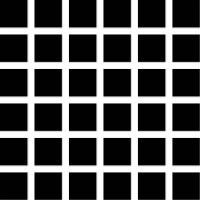
A Hermann grid illusion. Shape position and color contrast converge to produce the illusion of gray blobs at the intersections. The Hermann grid illusion was first reported by Ludimar Hermann in 1870, who discovered the illusion while reading John Tyndall's On Sound. In 1872, Ewald Hering observed that inverse colors (a black grid on a white background) produced similar results. Because of this, the Hermann grid is often referred to as the "Hermann-Hering" grid. |
Scintillating
grid illusions 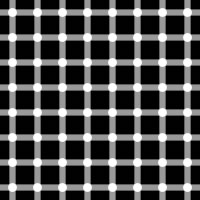 An example of the scintillating grid illusion. Dark dots seem to appear and disappear at intersections. The scintillating grid illusion is an optical illusion discovered by Elke Lingelbach in 1994, and is usually considered a variation of the Hermann grid illusion. Lingelbach and colleagues published their findings in a 1995 article entitled "The Hermann grid and the scintillation effect". |
|
Differences between the scintillating and Hermann grid illusions The difference between the Hermann grid illusion and the scintillating illusion is that scintillating illusions have dots already in place at the intersection, whereas there are no dots already in place at the intersections of Hermann grid illusions. Since they are so similar, the two names are commonly used interchangeably. But the scintillating illusion does not occur with an isolated intersection, as in the case of the Hermann grid; observations suggest that a minimum of 3 × 3 evenly spaced intersections with superimposed discs are required to produce the effect. This requirement suggests the participation of global processes of the kind proposed for the linking and grouping of features in an image, in addition to local processes. |
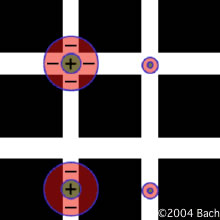 |
Why do we see the dark patches? |
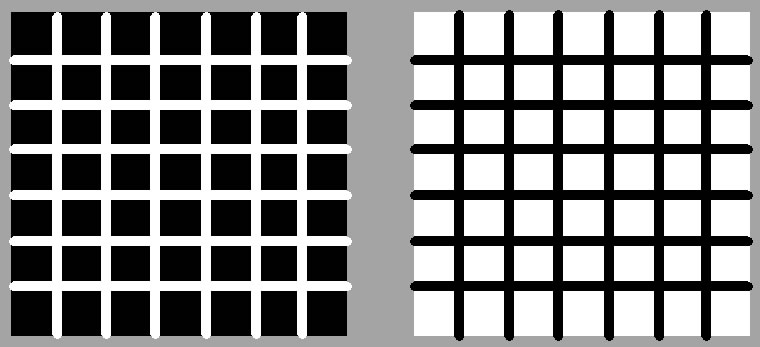
On the right the gray lines are in front and the smudges are darker gray.
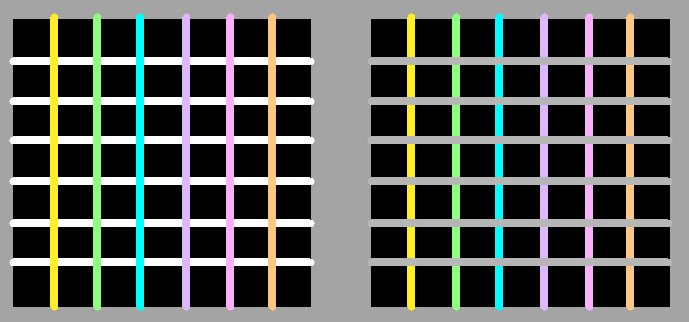 |
|
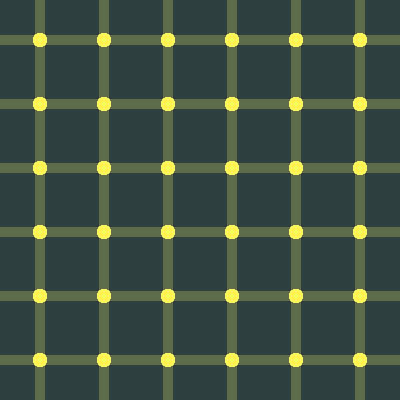 |
When the grid lines are straight, dark patches appear in the street crossings, except the ones which you are directly looking at.
When the streets are curving, the dark patches vanish.
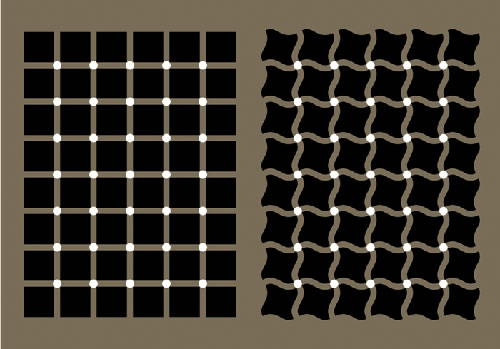 |
Illusory colored rays appear to run obliquely
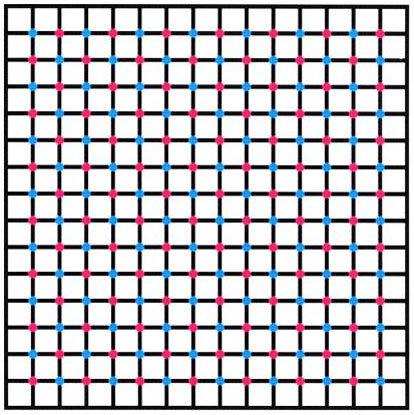 |
| Optical
Illusions REFERENCES: • "Hermann Grid" 1997. Illusion Works. Retrieved October 30, 2007. • "The Neural Control of Vision" MIT. Retrieved October 30, 2007. • "The Neural Control of Vision" MIT. Retrieved October 30, 2007. • Hermann L (1870). "Eine Erscheinung simultanen Contrastes.". Pflügers Archiv für die gesamte Physiologie. 3: 13–15. • Alexander, D.M.; Van Leeuwen, C. (2010). "Mapping of contextual modulation in the population response of primary visual cortex". • Baumgartner G (1960). "Indirekte Größenbestimmung der rezeptiven Felder der Retina beim Menschen mittels der Hermannschen Gittertäuschung." • Geier J, Bernáth L, Hudák M, Séra L (2008). "Straightness as the main factor of the Hermann grid illusion". Perception. 37 (5): 651–665. • Geier, János (2008). "Stopping the Hermann grid illusion by sine distortion". • Schiller, P. H., & Carvey, C. E. (2005). The Hermann grid illusion revisited. Perception-London, 34(11), 1375-1398. • Schiller PH, Carvey CE (2005). "The Hermann grid illusion revisited.". Perception. 34 (11): 1375–97. doi:10.1068/p5447. |
| |
|
|
| Copyright
© 2004 ABC-people.com Design and conception BeStudio © 2016-2018 |